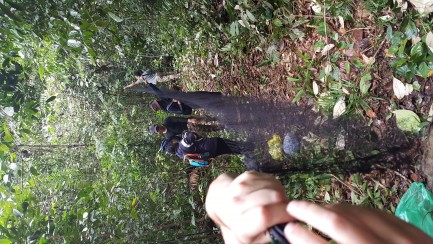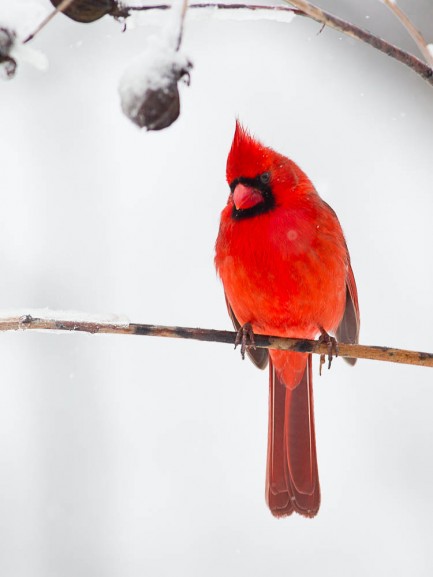More than 150 ornithologists, molecular biologists and computer scientists came together to obtain specimens and analyze more than 17 trillion base pairs of DNA.
Scientists Release Genomes of Birds Representing Nearly All Avian Families
Since the first bird evolved more than 150 million years ago, its descendants have adapted to a vast range of ecological niches, giving rise to tiny, hovering hummingbirds, plunge-diving pelicans and showy birds-of-paradise. Today, more than 10,000 species of birds live on the planet—and now scientists are well on their way to capturing a complete genetic portrait of that diversity.
In the Nov. 11 issue of the journal Nature, scientists from the Smithsonian Institution, the University of Copenhagen, BGI-Shenzen, the University of California, Santa Cruz and approximately 100 other institutions report on the genomes of 363 species of birds, including 267 that have been sequenced for the first time. The studied species—from widespread, economically important birds such as the chicken to the lesser known Henderson crake, which lives only on one small island in the Pacific Ocean—represent more than 92% of the world’s avian families. The data from the study will advance research on the evolution of birds and aids in the conservation of threatened bird species.
Together, the data constitute a rich genomic resource that is now freely available to the scientific community. The release of the new genomes is a major milestone for the Bird 10,000 Genomes Project (B10K), an international collaboration organized by researchers at the Smithsonian’s National Museum of Natural History, the Kunming Institute of Zoology, the Institute of Zoology in Beijing, the University of Copenhagen, The Rockefeller University, BGI-Shenzen, Curtin University (Perth), the Howard Hughes Medical Institute, Imperial College London and the Natural History Museum of Denmark, which aims to sequence and share the genome of every avian species on the planet.
“B10K is probably the single most important project ever conducted in the study of birds,” said Gary Graves, curator of birds at the National Museum of Natural History and one of B10K’s seven organizers. “We’re not only hoping to learn about the phylogenetic relationships among the major branches of the tree of life of birds, but we’re providing an enormous amount of comparative data for the study of the evolution of vertebrates and life itself.”
Comparing genomes across bird families will enable B10K researchers and others to explore how particular traits evolved in different birds, as well as to better understand evolution at the molecular level. Ultimately, B10K researchers aim to build a comprehensive avian tree of life that charts the genetic relationships between all modern birds. Such knowledge will not only reveal birds’ evolutionary past but will also be vital in guiding conservation efforts in the future.
More than 150 ornithologists, molecular biologists and computer scientists came together to obtain specimens and analyze more than 17 trillion base pairs of DNA for the family-level phase of the B10K project. Sequencing and analysis began in 2011, but the data represent several decades of work by field collectors and collections management staff who have collected and preserved birds from every continent, Graves said.
Approximately 40% of the newly sequenced bird genomes were obtained using tissue samples preserved in the National Museum of Natural History’s Avian Genetic Resources Collection, which Graves started in 1986 and has since become part of the museum’s biorepository in support of its broader Global Genome Initiative. Also contributing to the project were Michael Braun, a research zoologist at the National Museum of Natural History; Rebecca Dikow, who leads the Smithsonian Data Science Lab; and researchers with the Smithsonian’s National Zoo and Conservation Biology Institute and the Smithsonian Tropical Research Institute in Panama.
“It might seem that having a genome for each bird family or species is a bit like stamp collecting, but this massive cooperative effort has given us a set of very important genomic resources for conservation,” said Rob Fleischer, one of the authors and head of the Smithsonian Conservation Biology Institute’s Center for Conservation Genomics. “For example, it provides a ready source of genetic markers useful to map population declines, identify kin and reduce inbreeding when managing rescue populations of endangered species. Having the genomes simplifies the search for genes responsible for important survival traits such as resistance to deadly introduced diseases.”
“Through 34 years of field work and dozens of expeditions, we were able to get the stockpile of high-quality DNA that actually makes this project possible,” Graves said. “Many of those resources were stored long before DNA sequencing technology had been developed, preserved for future analyses their collectors could not have imagined at the time. It’s one of the many reasons why natural history museum collections and museum-based research programs are so important!”
With 363 genomes complete, B10K is expanding its efforts to encompass the next level of avian classification. In this phase, the team will sequence thousands of additional genomes, aiming to represent each of the approximately 2,300 genera of birds.
Funding and support for this research were provided by the Smithsonian, China National Genebank, the Chinese Academy of Sciences, the Carlsberg Foundation, the Villum Foundation, the National Natural Science Foundation of China, the European Research Council, the Howard Hughes Medical Institute, the National Institutes of Health, the University of Denmark and Louisiana State University.
Note to editors: Multimedia, including photos of birds, the Smithsonian research and support team in the field and the Smithsonian’s collections, can be found via Dropbox here (password: b10kgenome).
###
SI-219-2020
Ryan Lavery
202-633-0826
Randall Kremer
202-360-8770
Note to editors: Multimedia, including photos of birds, the Smithsonian research and support team in the field and the Smithsonian’s collections, can be found via Dropbox here (password: b10kgenome).












